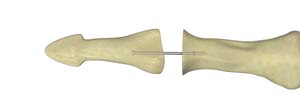Hand & Wrist Procedures
- LRTI (Ligament Reconstruction and Tendon Interposition) for Thumb CMC Arthritis

LRTI (ligament reconstruction and tendon interposition) is a surgical procedure that is most commonly conducted to treat thumb CMC (carpometacarpal) arthritis where the damaged joint surfaces are removed and replaced with a cushion of tissue that keeps the bones separated. To achieve this objective, surgeons remove part or all of the trapezium bone in the wrist.
- Osteotomy for Distal Radius Malunion

Osteotomy is a surgical procedure to cut and reshape deformed bones. Your doctor recommends osteotomy to correct distal radius malunion when non-surgical options such as splinting or physical therapy are unsuccessful.
- Wrist Open Reduction and Internal Fixation

Open reduction and internal fixation of the wrist is a surgical technique employed for the treatment of severe wrist fractures to restore normal anatomy and improve range of motion and function.
- Trapeziectomy

Trapeziectomy is a surgical procedure to treat a medical condition called “thumb base arthritis”. The procedure involves removal of a small, cube-shaped bone known as the “trapezium” at the base of the thumb joint which joins your thumb to your wrist.
- Peripheral Nerve Repair

The peripheral nerves are the nerve fibers that compose the area from head to toe, connecting the brain and spinal cord with the rest of the body parts.
- Wrist Arthroscopy

Wrist arthroscopy is a minimally invasive surgical procedure performed to view, diagnose and treat problems of your wrist joint.
- Wrist Joint Replacement

Wrist joint replacement surgery, also referred to as total wrist arthroplasty, involves the replacement of a severe arthritic wrist joint with an artificial joint made of metal and plastic components. It relieves pain and restores function when conservative treatment fails to provide relief.
- Carpal Tunnel Release Surgery

If conservative treatment options fail to resolve the condition your surgeon may recommend a surgical procedure.
- Elective Emergency Hand Surgery

Hand surgery is performed to restore the structure and functionality of the fingers, wrist and hand secondary to a traumatic injury, medical condition, severe infection, or birth defect causing pain and/or deformity of the hand. It is performed by trained and certified plastic surgeons.
- Wrist Ligament Reconstruction

Ligament reconstruction procedure can be performed as day surgery under local or general anesthesia.
- Total Wrist Arthrodesis

Arthrodesis is the surgical immobilization of a joint by the fusion of the adjacent bones.Total wrist arthrodesis, also known as wrist fusion, is a surgical procedure in which the wrist joint is stabilized or immobilized by fusing the forearm bone (radius) with the small bones of the wrist.
- Sports Injury Management of Hand, Wrist and Elbow

When you suffer an injury during sports events, never try to continue the activity in pain because it may cause further harm. Some injuries may require prompt attention by a doctor, while others can be treated at home.
- Hand Fracture Surgery

The hand is one of the most flexible and useful parts of our body. Because of overuse in various activities, the hands are more prone to injuries, such as sprains and strains, fractures and dislocations, lacerations and amputations while operating machinery, bracing against a fall and sports-related injuries.
- Artificial Finger Joint Replacement

Artificial finger joint replacement is a surgical procedure that involves the removal of an arthritic or damaged finger joint and replacement with an artificial prosthesis.
- Finger Joint Fusion

Finger joint fusion is performed under local or general anesthesia and usually takes about 2 hours to complete. A cut is made over the back of the finger joint and the soft tissues and nerves are carefully moved aside to expose the damaged joint.
- Surgery for Thumb and Digit Arthritis

Arthritis is an inflammatory condition of the joints. There are several types of arthritis; the most common type is osteoarthritis or wear-and-tear arthritis that affects the joint at the base of the thumb. Thumb arthritis is more common in women than men, and usually occurs after the age of 40 years.
- Xiaflex

Xiaflex is an injection consisting of enzymes that are used to break down stiffened tissue. It is used to treat conditions such as Dupuytren’s contracture and Peyronie’s disease.
- Arthroscopic Partial Wrist Fusion

Arthroscopic partial wrist fusion is a minimally-invasive surgery that uses tiny incisions to immobilize selected bones of the wrist. The wrist joint is one of the most complex joints in the human body. It is made up of carpal bones and the two bones of the forearm, the radius and ulna.
- Wrist Fracture Fixation

Wrist fracture fixation may be performed by surgical or non-surgical methods depending on the severity of the fracture...
- Distal Radioulnar Joint Arthroscopy

The distal radioulnar joint (DRUJ) is a pivot type synovial joint located between the radius and the ulna just proximal to the wrist joint and assists in pronation and supination of the forearm.
- DRUJ Arthroscopy

The DRUJ is the joint formed by the radius and ulnar bones of the foreman in the wrist. DRUJ (Distal Radioulnar Joint) arthroscopy is a minimally invasive surgical procedure to diagnose and treat pathological problems in the DRUJ using an arthroscope, a thin, flexible scope with a camera on the end.








